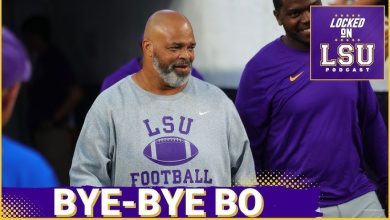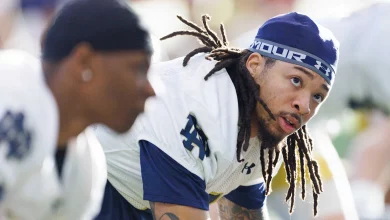Only Cedric Benson & Ricky Williams have more all purpose yards than Mike Adams WR.

In the storied history of Texas Longhorns football—a program defined by grit, greatness, and gridiron legends—few players have ever left a statistical legacy as rich and versatile as Mike Adams.
The electrifying wide receiver, who wore the burnt orange from 1993 to 1996, has officially cemented his place among the school’s all-time elite. With a staggering 5,403 career all-purpose yards, Adams now ranks third in Texas history, trailing only two of the most iconic names to ever play college football: Cedric Benson and Ricky Williams.
For many modern fans, Adams may not be the first name that comes to mind when reciting Texas greats. But the numbers—and the impact—are undeniable. While Benson and Williams racked up their yardage primarily through punishing ground attacks, Adams built his legacy through explosive speed, versatility, and a big-play flair that turned every touch into a potential touchdown.
Mike Adams arrived in Austin from Grand Prairie High School as a promising athlete with track-star speed and an instinctive feel for the game. What he became under head coach John Mackovic was one of the most dangerous and dynamic all-purpose threats the program had ever seen.
Standing just 5-foot-10 but with world-class acceleration, Adams wasn’t merely used as a traditional outside receiver. He was everywhere—lining up in the slot, returning punts, fielding kickoffs, and occasionally even taking handoffs out of the backfield. Every time he stepped on the field, defenses had to account for him.
And still, more often than not, they couldn’t.
Over the course of his four-year career, Adams consistently produced across every phase of the game. His all-purpose yardage includes:
- Receiving yards: 3,032
- Kick return yards: 1,846
- Punt return yards: 525
- Rushing yards: 82
- Total: 5,403
That total places him above some of the most prolific offensive weapons in Longhorns history, including Roy Williams, Shipley brothers Jordan and Jaxon, Jamaal Charles, and even Vince Young. His contributions weren’t just about volume—they were about impact. Adams scored 25 career touchdowns, many of them from long range, and led Texas in all-purpose yards for three consecutive seasons.
To understand the magnitude of Adams’s feat, consider the two players ahead of him:
- Cedric Benson (2001–2004): 5,540 all-purpose yards
- Ricky Williams (1995–1998): 7,206 all-purpose yards
Both were Doak Walker Award winners and cornerstone running backs of their eras. They had the benefit of 25–30 touches per game and offenses built around them. Adams, on the other hand, maximized every opportunity he had—whether it was a slant route, a punt return, or a reverse.
“He wasn’t the biggest guy on the field,” said former Texas quarterback James Brown, who played with Adams from 1994–1996. “But he was the fastest, the most creative, and the most dangerous. Mike changed games with one play.”
Adams built a career full of highlight moments, and while statistics tell part of the story, his impact often went beyond the box score. A few unforgettable performances include:
- 1994 vs. Oklahoma: Adams exploded for 259 all-purpose yards, including an 88-yard kickoff return touchdown and a 54-yard reception on a deep post route. Texas won 17–10 in a game dominated by field position—and Adams flipped it every time he touched the ball.
- 1995 vs. Baylor: Adams caught 6 passes for 124 yards and 2 TDs, returned 3 kicks for 102 yards, and returned 4 punts for another 60—accounting for nearly 300 total yards in a 21-point win.
- 1996 vs. Texas Tech: With the game tied late in the fourth quarter, Adams took a punt back 66 yards for a touchdown—his final career return score in DKR Memorial Stadium, and one that sent the fans into a frenzy.
By the end of his college career, Adams had returned four kicks for touchdowns, caught 15 touchdown passes, and recorded more than 30 plays of 30+ yards.
Long before today’s hybrid wideouts blurred the lines between receiver, back, and returner, Adams was setting the standard.
At a time when college offenses were still largely pro-style or run-heavy, Adams thrived as a multi-use, open-space creator—the kind of player that coordinators dream of building a system around. His elite short-area burst and long-speed made him almost impossible to hem in on first contact.
He became a predecessor to modern players like Deebo Samuel, Tavon Austin, or Percy Harvin—not in system, but in effect. Every time the ball touched his hands, something dramatic could happen.
And often, it did.
Adams’s value to the Longhorns extended far beyond his offensive numbers. On special teams, he was nothing short of electric.
- 3 career kickoff return touchdowns
- 1 punt return touchdown
- 22.1-yard career kick return average
- Over 200 combined returns
His instincts and balance allowed him to find creases in coverage units. His field vision—an underappreciated asset for return men—was among the best the program had seen at that point.
“You could hear the stadium take a deep breath when Mike lined up to return a kick,” said former Texas radio announcer Bill Schoening. “Because they knew—he might be gone in ten seconds.”
Though Adams played nearly 30 years ago, his career has taken on renewed relevance in today’s game, where positionless playmakers are more valuable than ever.
In an era that rewards explosive, multi-phase players through NIL exposure, NFL draft buzz, and national media attention, a player like Adams would’ve been a household name coast to coast. His ability to dominate all-purpose categories now reads like a blueprint for how modern programs use elite athletes.
More than anything, his career serves as a reminder: impact is about more than position or production—it’s about presence. And Mike Adams was one of the most electric presences Texas football has ever seen
After leaving Texas in 1996, Adams spent time with several NFL teams, including the Pittsburgh Steelers and Minnesota Vikings. While he didn’t have a long pro career, his football IQ and leadership translated well into coaching and mentorship roles.
In recent years, Adams has remained close to the Longhorn community. He’s made appearances at alumni events, spoken at youth football clinics, and even been honored during Texas home games as one of the program’s most underappreciated legends.
In a 2024 Longhorn Network special, Adams reflected on his career:
“I didn’t play for records. I played for my brothers, for the fans, and for the love of the game. To know I’m up there with Ricky and Ced—man, that’s humbling. That’s Texas football.”
It’s easy to overlook players whose greatness comes not from overwhelming size or raw stat lines, but from consistency, versatility, and the ability to show up in every phase of the game.
Mike Adams wasn’t just a receiver.
He wasn’t just a returner.
He was a weapon—a Swiss Army knife in a helmet and shoulder pads, capable of slicing through defenses from any angle, in any moment.
Now, with only Cedric Benson and Ricky Williams ahead of him on the Texas all-purpose yardage list, his legacy is no longer quiet.
It’s carved into the fabric of Longhorn history.









